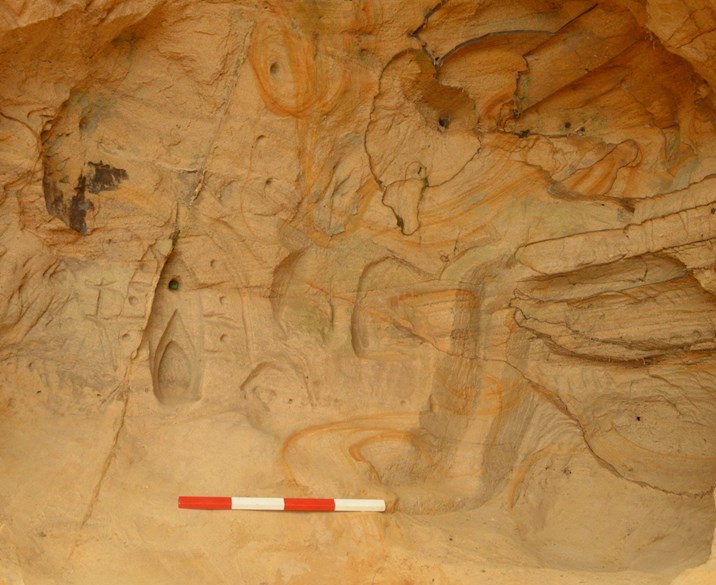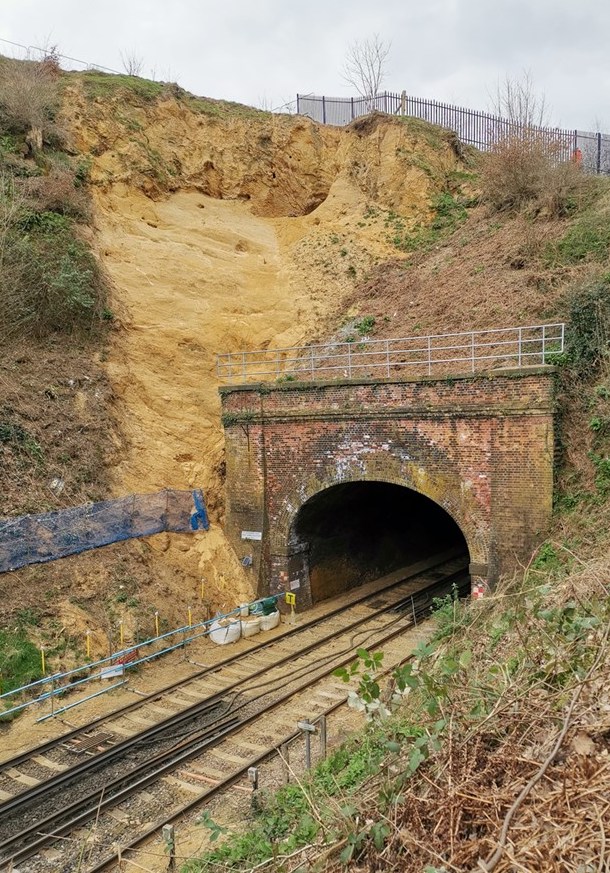 Abraham Lincoln
If given the truth, the people can be depended upon to meet any national crisis...
Abraham Lincoln
If given the truth, the people can be depended upon to meet any national crisis...
 Guildford news...
for Guildford people, brought to you by Guildford reporters - Guildford's own news service
Guildford news...
for Guildford people, brought to you by Guildford reporters - Guildford's own news service
Revealed: Markings Inside the Mystery Medieval Cave Found at St Catherine’s Hill
Published on: 6 Apr, 2020
Updated on: 5 Apr, 2020

What is left of the cave following the construction of the railway tunnel in the 19th century and recent regrading work.
By Martin Giles
Experts believe the cave discovered last week by rail workers repairing a landslip below the ancient chapel on Guildford’s St Catherine’s Hill dates from the 14th century.
The sandstone cave is made up of several sections ranging from 0.3 metres to about 0.7 metres high. Originally it may have been much larger, but only this small part survived the digging of the railway cutting through the hill in the early 1840s.
Initial findings by a specialist archaeologist suggest the cave was a later medieval shrine or hermitage associated with the early 14th century chapel of St Catherine, the ruins of which overlook the Old Portsmouth Road in the south of the town.
The site may even have earlier origins in pagan religious activity, due to its pre-14th century name of Drakehill or Hill of the Dragon.
Images taken from the cave show a Gothic niche decorated in dots with a Calvary cross nearby.

The gothic arch and a calvary cross to its left, evidence initial examinations have led experts to believe that the cave contained what might have been medieval shrines.
There are about seven or eight further niches and experts found considerable evidence of writing and other markings across the ceiling.
The cave is partially covered in deposits of black dust, believed to be soot from lamps.
The remains of two suspected fire-pits were also uncovered in the floor. Radiocarbon dating may be used to establish the exact period when the cave was in use.

The cave lies above the southern end of St Catherine’s sand tunnel. It was from this area that the December landslip, which briefly closed the Guildford to Portsmouth mainline, originated.
Archaeologist Tony Howe, Surrey County Council’s Historic Environment planning manager, said: “The discovery of this cavern is tremendously exciting. It’s very early in the process of understanding its full significance, but the potential for knowledge acquisition is huge.
“We’re looking forward to learning an awful lot more about the site as studies progress.”
A spokesperson from Archaeology South East, said: “The cave contained what appear to be shrines or decorative niches, together with carved initials and other markings.
“This has obviously been a site of ritual significance long before the construction of the chapel.
“Work is underway to analyse soot and charcoal found inside the cave, which will hopefully tell us more about how and when it was used.”

Matthew Alexander
Matthew Alexander, the former curator of Guildford Museum and the borough’s honorary remembrancer, commented: “Potentially, this is one of the most exciting historical finds to have been made in Guildford for decades. It might well be of 14th century date, and could quite feasibly have been a hermitage.
“Hermits frequently chose caves as dwellings, either natural or dug out by hand. Usually, there was a space set apart as an oratory or chapel for their devotions. Sometimes their life of solitary worship and prayer could be combined with public works – such as operating a ferry.”
A ferry is known to have operated at the foot of St Catherine’s Hill in medieval times and continued until the 1960s.
But Mr Alexander warned: “All this is speculation, of course, and we eagerly look forward to seeing the forthcoming archaeologists’ report to furnish more details.”
 Mark Killick, the Network Rail Wessex route director, said: “This is an unexpected and fascinating discovery that helps us visualise and understand the rich history of the area.
Mark Killick, the Network Rail Wessex route director, said: “This is an unexpected and fascinating discovery that helps us visualise and understand the rich history of the area.
“A full and detailed record of the cave has been made and every effort will be made to preserve elements where possible during the regrading of the delicate and vulnerable sandstone cutting.”
See also:
Mystery Medieval Cave Discovered Below Guildford’s Historic St Catherine’s Chapel
More Revelations on St Catherine’s Cave Expected Soon
Letter: A Cave on St. Catherine’s Hill
Letter: Is Oil Seepage A Clue to the Hill Cave Mystery?
Responses to Revealed: Markings Inside the Mystery Medieval Cave Found at St Catherine’s Hill
Leave a Comment Cancel reply
Please see our comments policy. All comments are moderated and may take time to appear. Full names, or at least initial and surname, must be given.Recent Articles
- City Gain First Away Win at Thatcham
- Letter: Stoke Mill Needs Protection
- Letter: Why Is No One Applying to Waverley Council’s CIL Review Scheme?
- Highways Bulletin: Supporting You Through Local Roadworks
- Warning Over Rising Risk of Type 2 Diabetes in Guildford
- Letter: The Lack of Political Will to Fix the CIL Issue at Waverley Is Worrying
- Notice: Heritage for All
- Letter – Waverley Council’s Answers on CIL Just Don’t Make Sense
- Cyclist Seriously Injured in East Clandon Collision – Police Seek Witnesses
- GBC Admits ‘Significant Failings’ Over Couple’s Home Improvement Ordeal



Recent Comments
- Maria Dobson on Letter: The Lack of Political Will to Fix the CIL Issue at Waverley Is Worrying
- Ian Colvin on Letter: The Lack of Political Will to Fix the CIL Issue at Waverley Is Worrying
- S Callanan on A3100 Guildford to Godalming Portsmouth Road Re-opened
- Tony Harrison on A3100 Guildford to Godalming Portsmouth Road Re-opened
- Murray Rowlands on Woking Council’s Big Bailout – Government Gives Extra £75m
- Peta Malthouse on Pay Rise for Joint Guildford-Waverley CEO Agreed
Search in Site
Media Gallery
Dragon Interview: Local Artist Leaves Her Mark At One of England’s Most Historic Buildings
January 21, 2023 / No Comment / Read MoreDragon Interview: Lib Dem Planning Chair: ‘Current Policy Doesn’t Work for Local People’
January 19, 2023 / No Comment / Read MoreA3 Tunnel in Guildford ‘Necessary’ for New Homes, Says Guildford’s MP
January 10, 2023 / No Comment / Read More‘Madness’ for London Road Scheme to Go Ahead Against ‘Huge Opposition’, Says SCC Leader
January 6, 2023 / No Comment / Read MoreCouncillor’s Son Starts Campaign for More Consultation on North Street Plan
December 30, 2022 / No Comment / Read MoreCounty Council Climbs Down Over London Road Works – Further ‘Engagement’ Period Announced
December 14, 2022 / No Comment / Read MoreDragon Interview: GBC Reaction to the Government’s Expected Decision to Relax Housing Targets
December 7, 2022 / No Comment / Read MoreHow Can Our Town Centre Businesses Recover? Watch the Shop Front Debate
May 18, 2020 / No Comment / Read More













Nigel Searle
April 6, 2020 at 11:32 am
“The sandstone cave is made up of several sections ranging from 0.3 metres to about 0.7 metres high.”
Could this be clarified please? These dimensions appear far too low for ease of human access, particularly if the banded pole shown in one of the images is a metre (100cm) long. Perhaps the 0.3 and 0.7 metres refer to the height of the niches?
Nevertheless, a fascinating discovery.
A spokesman for Network Rail responded: “It is the cave’s niches which are up to about 70 cm high. The cave entrance is bigger.”
Jan Messinger
April 6, 2020 at 2:26 pm
We must thank the Guildford Dragon NEWS for publishing the two pieces we have had today in relation to the incredible find by network rail of what is believed to be 14th-century small cave at St Catherine’s.
The Telegraph has just published a piece now. But you heard it first in The Guildford Dragon.
Colin Reardon
April 7, 2020 at 4:39 pm
Could the caves have been an overnight resting site for Pilgrims walking from Winchester to Canterbury as the Pilgrims Way passes down Ferry Lane?
Matthew Alexander, former curator of Guildford Museum, responds: “It would be hard to think of a historical notion more widely held in Surrey, and more cherished, than that of the Pilgrims’ Way. Yet there is no evidence that a single medieval pilgrim ever went from Winchester to Canterbury along it.
“A Victorian antiquarian, Albert Way, first suggested the idea. Captain Edward James, a Royal Engineer surveying Surrey in the 1860s for the Ordnance Survey, accepted it as a historical fact, and marked it on his maps. He also published a booklet which elaborated on the story, but without any medieval evidence to support it.
“Since then books, magazine articles, films and television programmes have endlessly repeated the tale, establishing the ‘Pilgrims’ Way’ in the minds of the people of Surrey for ever.”
Mary Alexander
April 9, 2020 at 7:58 pm
If anyone did travel from Winchester to Canterbury in the Middle Ages they would have gone via London, along decent roads where there were inns to stay in, not along a featureless track with nowhere for food and drink. Or, they might have gone by sea from Southampton.
However, there may well have been pilgrims who visited the chapel. All churches had to have relics, and presumably chapels also.
St Catherine’s chapel may have got a reputation locally because of a statue, a picture or relic. Perhaps some desperate person experienced a cure, or someone saw a vision. It might attract pilgrims for a few years, then fade away. We shouldn’t imagine the chapel being used in exactly the same way for 250 years. It would have been closed around 1540, as part of the Reformation.
Valerie Thompson
April 11, 2020 at 8:30 am
I’m not sure that the claims that the Pilgrims Way is only Folklore are correct. The Pilgrim’s Way went through Guildford, along the North Downs, past places such as West Horsley, where the church has a wall painting of St Christopher and the jettied house next door was the former inn. The route is well documented. These tracks were maybe safer than main roads, more vulnerable to highwaymen.